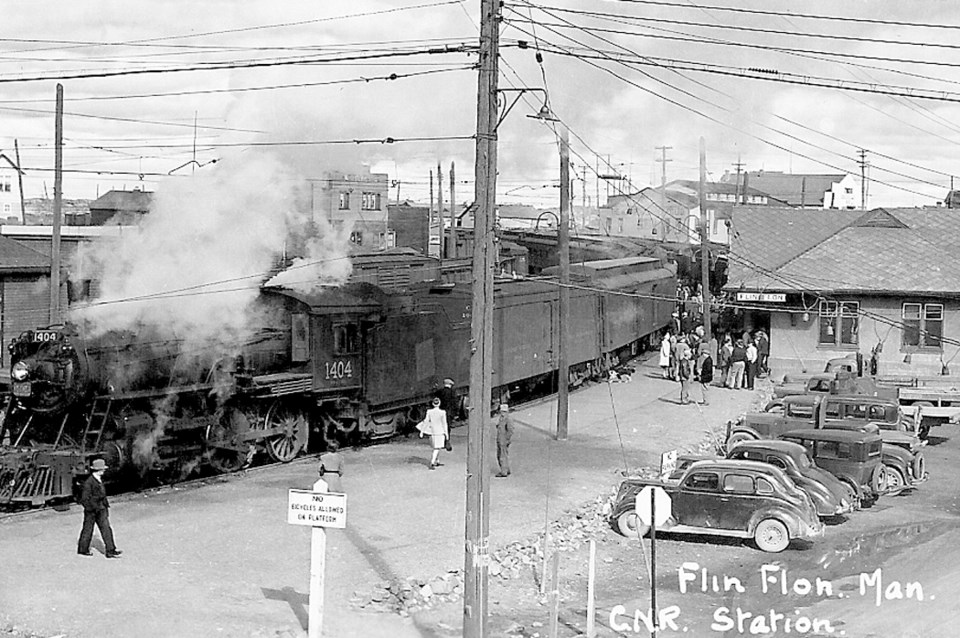Readers of this column were taken for a ride last month. That is, they were taken for a train ride as we reminisced about the importance of passenger train service in the early days of Flin Flon’s development. As with many things, the joy of train travel came to an end in the mid-‘50s due mostly to the completion of Highway 10 link to the south.
It didn’t take much time for the locals to get their hands on a car and then make their way south over gravel, muck, potholes, dust and constant construction. The steam engine was on its way out as diesel/electric engines proved their worth across North America. Thus the Flin Flon train consist dropped from an express car, two day coaches, a dining a car and sleeper to a single diesel passenger/freight unit that was unlovingly referred to as The Skunk due to the odour of diesel fumes that permeated the passenger section.
Prior to the construction of Highway 10, the train was the heart of communication with the outside world. If you ate it, drank it, wore it, made use of it, it came to Flin Flon by train. Special to the freight office were the crates of eggs sent from southern farms to local residents. My mother would order a crate of 15 dozen fresh eggs from a farm family near Gilbert Plains and then divvy them up amongst her friends. Fresh farm cream, butter, honey and potatoes would be sent north. Christmas brought a rush of frozen turkeys from any number of family farms. My dad’s brother Harold would wrap a turkey from his farm in Elgin, Manitoba where the travellin’ turkey would then roll on to Brandon, change trains at Brandon and Melville and arrive in Flin Flon just in time for Christmas. The train was also heavily burdened both ways with Christmas mail and thousands of parcels send by family and friends plus the orders from the Simpson and Eaton’s Christmas catalogues.
Those two ribbons of steel that wind their way through the Boreal forest and then along the rocky shores of the Shield country essentially carried commerce in and out of Flin Flon and still provide a valuable service to the production of the Flin Flon mine site operation.
Travelling by train was a shared experience of conversation and camaraderie – and adventure, such as the time my mother loaded my brother and I onto the train for our summer journey to our Uncle Albert’s farm near Regina. The three of us would take the day coach and somehow sleep on the bench seats. Bless my dear mother, though, as she managed to save up a little extra so that we boys from the bush could enjoy a breakfast in the dining car. Imagine, white linen table cloths, silver service, ordering from a menu all the while rattling along out of the bush and on to the prairies. We’d be well south of Hudson Bay when we sat down for our special breakfast, my brother and I each taking a window seat. All the better to watch the world go by. The train by now had reached the northern end of rural settlement so it would stop and go at every station along the line – Sturgis, Tiny, Amsterdam, Canora, Gorlitz.
We were just finishing our breakfast when the train rolled into Gorlitz. There was the usual crowd on the station platform including two rough and tumble farm lads of our age who gazed up in envy at those two ‘rich kids’ riding in the dining car. What to do but for my brother and I to pick up our teacups and put on a big show about our “status.” Kids! It was many years later that I met a man of my age who came from Gorlitz. He told me about the times he and his brother would come to town and watch the train come in.
I didn’t ask if he saw those two high falutin’ kids in the dining car.
Flin Flon railway quiz: Why were there bigger families in Mile 84 during the years of train travel? A
5 am train would whistle for the Third Avenue crossing and, well, it was to soon to get up for work, and too late to go back to sleep!




